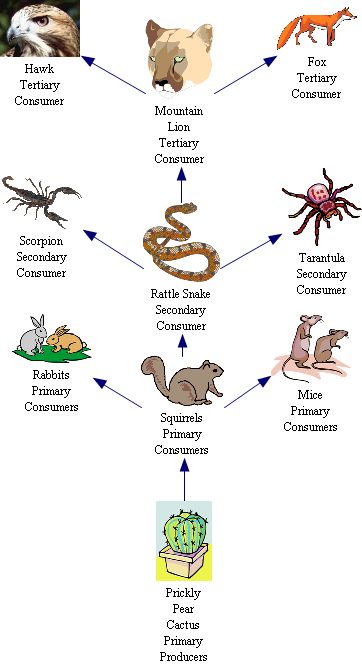Basic Information
Description
The desert can be both a hot and dry place and a cold barren wasteland that is full of snow like in Antarctica. In hot and dry Deserts, temperatures can range from 20-25 degrees Celseus. In cold deserts, the temperatures are around 2-4 degrees Celseus. You won't find a vast amont of different plants like the rainforest or the grasslands, but you will find many different kinds of shrubs and cacti. The animals in the desert are mostly nocturnal, or active mostly at night. This is because it is a lot cooler at night and more confortable. Also, you may find animals that are able to burrow and live underground to escape the heat during the day. Different deserts have different life.
Location
The desert can be found all over the globe. You can find hot deserts near the Tropic of Cancer and the Tropic of Cancer. Cold deserts are mostly found in the north and south poles. Some examples of deserts are the Mojave desert and the Sahara desert.
Climate
The desert has a dry tropical climate. The average temperature of most dry deserts is 64 degrees farenheit. For rain, the average amount of rainfall a year is about one inch.
Life in this Biome
In the desert, plants must adapt to the lack of water. To do this, the roots absorb the little water that falls each year. Then the water is stored in the bottom of the trunk or stem. There are many plants that have adapted like this. The cactus and shrubs are a few examples. Animals in this biome are mostly nocturnal animals due to the intense heat during the day. The animals, however, must be able to burrow underground or in trees to keep cool.
Environmental Threats
Discuss an environmental issue and explain why it is important to address:
There are many environmental threats that threaten the desert. One environmental threat is global warming. Global warming is important to the environment because it heats up the world. The desert is very warm and global warming just makes it hotter. This is not good for all the plants and animals that live in this biome. It makes it more difficult to avoid the heat.
Discuss efforts currently underway to address this issue:
There are really no efforts to fix global warming in the desert; howerver, there is reasearch going on that helps try to figure global warming out. We can't really stop global warming because it is natural. What we may be able to do is probably to look into it more and attempt to slow the process down.
Food Web

Plants of the Desert
- Joshua Tree Yucca brevifolia
Physical Description: The Joshua Tree has yellow-greenish flowers and produces a green and brown fruit that helps support the wildlife that it surrounds.
Adaptations the Allow for Success: One reason that the Joshua Tree can survive is its ability to survive in high elevations going from 2,000 to 6,000 feet. Another reason is because the Joshua Tree has two root systems. The first root system is made to store water and create "bulbs". The second root system is a shallow root system.
Reproduction: The Joshua Tree has a usual lifespan of 200 years and in grows three inches a year for the first ten years of its life and in the following years growing 1.5 inches. Joshua Trees are easily produced growing from the fallen seed of other Joshua Trees.
Interesting Relationships: The Joshua Tree is pollinated by the Pronuda Moth, otherwise know as the Yucca Moth. The Joshua Tree is only found in the Joshua Tree National Park where it can be kept safe.
|
 |
|
Palo Verde Circidium microphyllum
Physical Desrciption: The Palo Verde is a shrub that has a thick waxy green bark, studded with large thorns. During seasons the Palo Verde sheds some branches to stay alive.
Adaptations: The Palo Verde drops leaves during dry parts of the seasons preventing water loss and adapts well with the arid climate it lives in.
Reproduction: Seeds are produced when the spring has been wet and cool.
Native Content: Grows in the Sonoran Desert, Can be grounded into flour, red dye can be made from flowers.
Interesting Relationships: Rodents feed off of seed, and the Palo Verde is also used by animals as nests, shelter, and food.
|
 |
Comments (10)
wikiuser0106 said
at 11:45 am on May 19, 2009
This wiki is really good so far. The information is easy to read and understand. Also, the information is layed out well. QAll it needs is a little more information. -Jenna S. P.5
Sara Sefcheck said
at 5:15 pm on May 19, 2009
Missing lots of info.
wikiuser0116 said
at 11:16 am on May 20, 2009
hey we could use four more producers on the food web
wikiuser0050 said
at 5:14 pm on May 20, 2009
pictures?
wikiuser0125 said
at 6:21 pm on May 20, 2009
you need more info the plants. -Austin Laforteza P5
wikiuser0051 said
at 9:20 am on May 21, 2009
For the most part it was very informative. THe only problem that i saw is the visual affects on it. It seems to be slightly bland.
Kendal P.3
wikiuser0054 said
at 9:35 am on May 21, 2009
The visuals are very good but you are missing like some graphs
wikiuser0054 said
at 9:35 am on May 21, 2009
that last comment was from Jacob P - p 3
wikiuser0099 said
at 10:27 am on May 21, 2009
Don't you mean the Tropic of Cancer and the Tropic of Capricorn Micheal P.4
wikiuser0126 said
at 10:40 am on May 21, 2009
I like the food the visuals, the info is very easy to read and understand. Hunter Gorman P.5
You don't have permission to comment on this page.